#protein per meal
Explore tagged Tumblr posts
Text
Optimizing Protein Intake: How to Reach 100g Per Day
Table of Contents Do You Really Need 100 Grams of Protein Per Day? Why Protein Matters Protein is essential for building and repairing muscles, joints, and other tissues. It is also a vital component of enzymes, hormones, and energy. Studies show that adequate protein intake helps build and maintain muscle mass, control appetite, keep bones healthy, and support weight loss. Does Everyone Need…
#100 grams of protein#daily protein needs#dietitian tips#fitness goals#healthy eating#high-protein snacks#muscle building#protein after workout#protein benefits#protein for athletes#protein for older adults#protein for weight loss#protein guidelines#protein intake#protein myths#protein per meal#protein requirements#protein sources#protein-rich foods#Weight Loss
2 notes
·
View notes
Text
.
#annual physical tomorrow. getting slightly defensive in advance for when they ask me how i eat and exercise#and i say 'im vegetarian and i cook almost all my meals at home and don't eat fast food and get a lot of vegetables and protein'#'and i currently exercise at least some every day. often a solid hour or more of intense exercise at least a few times a week.#i bike to get around and i rock climb and hike and lift weights and run/jog and sometimes swim. i get typically 10+ hrs of exercise per wee#i can run 5 miles without issue if my ankle doesn't bother me. biking 30+ is no problem. '#and the doctor looks shocked and replies with some variant of 'so why are you overweight'#which is about what happened last time.#for the sake of the scenario playing in my head i am playing the soundbite 'got chub from eating too much PUSSSYYYYY' to break the cycle.#'are there any health goals you want regarding ur weight' 'yeah a fatter ass and hella thighs'#idk. mind ur manners. at least do your best not to act surprised.#and like. i am only slightly overweight and i do have the athleticism to say 'and what about it' and i just.#this is the most benign version of that response. i wish better for everyone else who gets some variation of it#not that ANYONE asked but i am 50 lbs heavier than i was when my mom tried to control my weight as a teen#and im fine. that's fine. it is not unhealthy.
3 notes
·
View notes
Text
20 ways to increase your protein intake at every meal
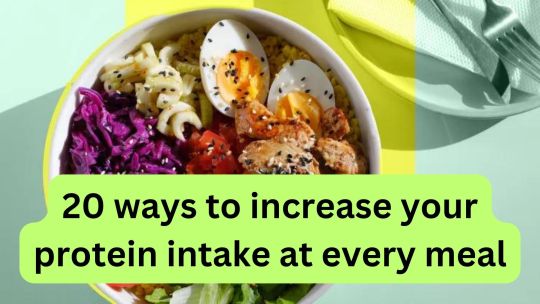
You don't have to be a professional athlete to get more protein in your diet. No matter your activity level, protein serves all kinds of important purposes in your body, from repairing damaged tissue to making important hormones and enzymes. Research also shows that protein is the most satiating nutrient, so eating more of it is associated with better weight management. Also, the older we get, the higher our daily protein needs. In short, we can all benefit from getting enough coffee.
Do you feel lacking in the protein department and want to increase your intake? There are plenty of easy ways to sneak macros into meals and snacks—even if you don't want to add protein powder to everything you eat. Here are 20 delicious ideas to try during the day.
Ways to increase protein intake at breakfast
Add protein-rich foods to your breakfast recipes. With the right ingredients, even the most carb-heavy breakfast can get a protein boost. Consider how you can incorporate protein-rich foods into your breakfast routine. Add peanut butter to oatmeal, make a breakfast burrito with black beans or eggs, or blend silken tofu into a smoothie.
Add a protein supplement or powder to breakfast
Ideal for adding a lot of protein powder to breakfast. Sprinkle a spoonful into muffin batter, oatmeal, or smoothies.
Choose a protein-rich breakfast when you eat out
On a busy morning, sometimes running through the driveway is unavoidable. When eating out for your first meal of the day, try to focus your menu on protein-rich options like egg sandwiches or bean wraps. If possible, be sure to check the rest of the product's nutritional information. Often fast food that is high in protein is also high in saturated fat and sodium.
Add collagen to hot drinks
Collagen powder not only dissolves easily in hot beverages like coffee or tea, but it packs 15-20 grams of protein per serving, depending on serving size. Add a scoop to your morning smoothie for a protein boost without breaking the bank.
Ways to increase protein intake at lunch
Eat protein first
At lunch, you may be tempted to dig into a bag of chips or crackers before starting your protein choices. But it is best to use the highest amount of protein in the meal first. That way, you're more likely to fill up on these satisfying macros than on low-quality carbs.
Make the most of leftovers
Since dinner is the highest protein meal of the day, why not extend its effects into tomorrow's lunch? Make a little extra dinner so you can reap the protein-rich benefits the next day.
Picture a protein-rich plate
In the USDA's Dietary Guidelines MyPlate (a handy visual for what a healthy, wholesome meal looks like), protein covers almost a quarter of the plate. Grain, which also contains protein, is only about a quarter. Keep this picture in mind when preparing lunch. This will help you ensure that your lunch provides enough protein.
Ways to increase protein intake at dinner
Plan meals around protein
In addition to being a great way to save time and money, meal planning allows you to get serious about adding more protein to your dinner. When you sit down to plan your week, start by deciding which protein will anchor each dinner.
Choose protein-rich sides
Main dishes usually provide the most protein on your plate—but that doesn't mean sides can't add to your mealtime, too. Many side dishes offer a lot of protein. For example, refried beans can add this macro to a Mexican dinner, quinoa is a protein-rich side for meat, and a dollop of Greek yogurt adds protein to creamy sauces.
Choose the right meat
Thinner cuts of meat generally offer more protein than thicker cuts of meat. Round-eye, top sirloin, and sirloin tip steak are leaner, higher-protein cuts of beef, while skinless chicken or turkey are leaner, higher-protein poultry choices.
Ways to increase protein intake before snacking
Make your own protein snacks
Making your own high-protein snacks at home gives you complete control over your favorite ingredients and flavors. To save time, try making large batches of snacks that you can freeze, like DIY protein balls or bars. Then, during the week, take them out when there is an afternoon hunger strike.
You can do the same with shelf-stable snacks. Make a trail mix with nuts and seeds or roast some chickpeas with your favorite spices. Then divide them into ziplock bags for easy snacking.
Choose lightly processed store-bought snacks
Store-bought protein snacks may offer up to 20 grams per serving, but beware: some are processed. For your health, try to buy protein-rich snacks that are less processed. Look for bars, balls, jerky, or nuts with short ingredient lists and few additives.
Pair carbohydrate snacks with protein
Think fast: What proteins can you pair with your typical carb-based breakfast? If your usual afternoon snack is a handful of pretzels, try dipping them in peanut butter. Or if you enjoy berries mid-day, consider mixing them into yogurt.
Fire up your smoothies
For a protein-rich snack, there's no more versatile option than a smoothie. Starting with a base of Greek yogurt or silken tofu (along with some fruit for color and flavor), the sky's the limit for other high-protein additions. Add peanut butter, oats, protein powder or soy milk to the mix and mix!
#protein#how much protein do i need to build muscle#how much protein can your body absorb per meal#increase protein intake#how to eat more protein#protein intake#how to increase protein intake#high protein meals#how to increase your protein intake#high protein foods#how to increase protein intake in your diet#increase your protein intake#how much protein to build muscle#protein sources#increase protein intake in your diet#high protein#high protein breakfast
3 notes
·
View notes
Text
I hate how obsessed some folks are with protein. And those who feel the need to lecture others while acting like you have to drink a expensive highly processed supplement to be healthy, when real food is more than sufficient. And you’d be surprised how low your daily needs might be, it’s 1 gram of protein per .8 kilo of body weight ( or about half your weight )
There’s numerous studies showing that most people actually are eating too much of it and getting sick
#Americans eat way too much protein#I’m sorry I don’t want lecture about that from people who act like you gotta eat expensive highly processed protein supplements to be health#I actully was ripped like crazy when I was struggling#bc I still lifted and ate real foods#i can see supplements if you have a very limited diet but they are still too much#and the perception of what we need is also warped#it’s only half your weight in grams#protein always makes me more hungry anyway#and makes me so bloated and constipated#my aunt said people should have 80 grams per meal#it’s always the fat folks saying it too#they act like protein is an excuse to eat as much or a free reason to pig out#there’s studies from Harvard sayinv Americans eat too much protein and it’s making us sick#the protein cookies and junk food are ridiculous- it doesn’t erase the fat or sugar just cause you put protein in a cookie!#a grown man only needs 56 grams#i always get so tired and have to pee constanty if I have a protein binge
0 notes
Text
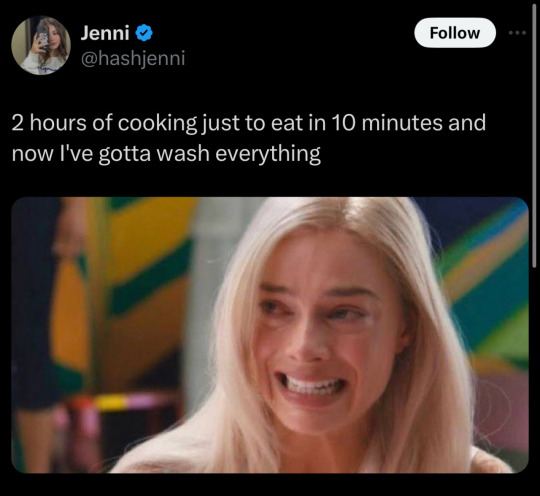
i had to make a solution for this for myself, mostly because of depression, but it makes a nice How To for folks who are low on spoons or could use some help in the kitchen.
Fortunately i was a professional cook for over a decade. UNfortunately the first post i made explaining it was suuuuper long. Let's see if i can do better
So you select any protein that you can cook in a frying pan -- chicken breasts, ground beef, pork chops, sausages, steak, chicken thighs, whatever. You also select one or two types of veggie (mushrooms or tubers also work, i just did this with potatoes and carrots for dinner tonight).
[i like cooking for vegetarians, but this is how i cook for myself when i'm low on spoons - perhaps i'll do another post for meatless meals]
You'll also need some kind of oil, and a sauce or two of your choice in a bottle. All cooking gear is a large frying pan with lid (i prefer non-stick) a spatula, a cutting board, and a knife.
You cut the veggies into bite size pieces, cut up enough for two meals. One kind of veggie is fine, or you can do mix two or three

Put frying pan on medium heat with a little oil. Tubers or mushrooms or go in the pan a few minutes before the protein. 2 portions of the protein goes in the pan, about 5 minutes with lid (don't worry you can still get a good sear on both sides)
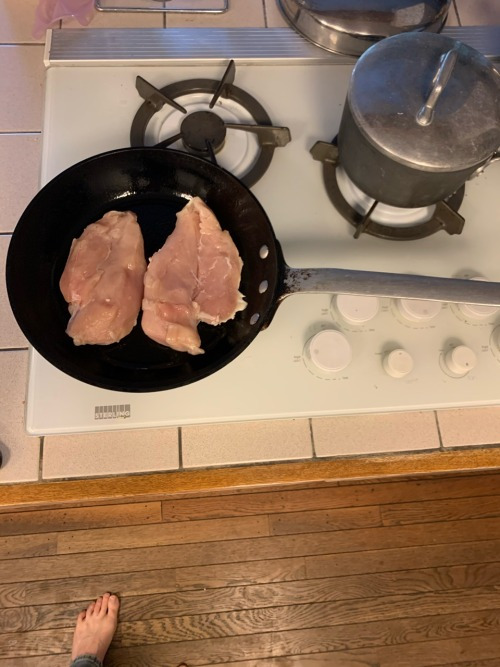
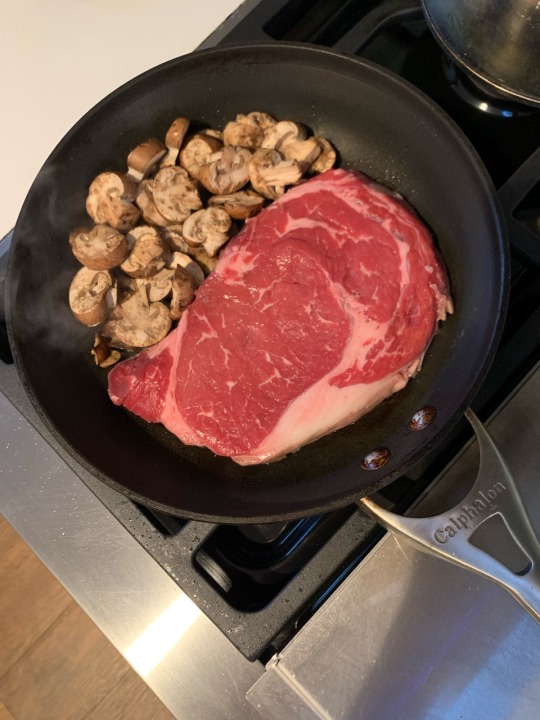
Now flip your protein if it's flip-able and add normal veggies, put the lid back on another five-ish minutes.
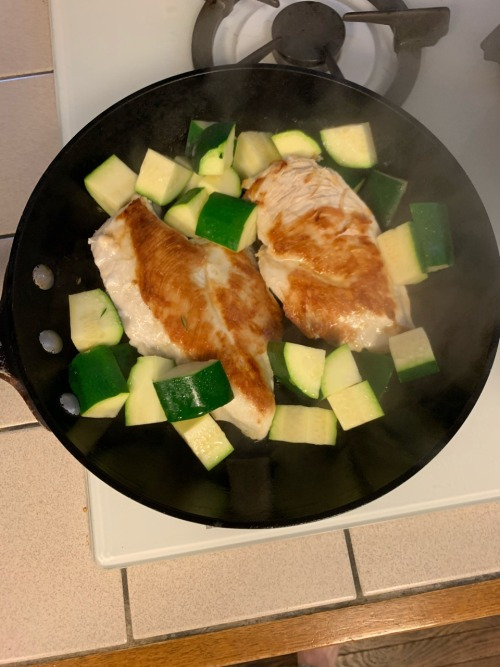
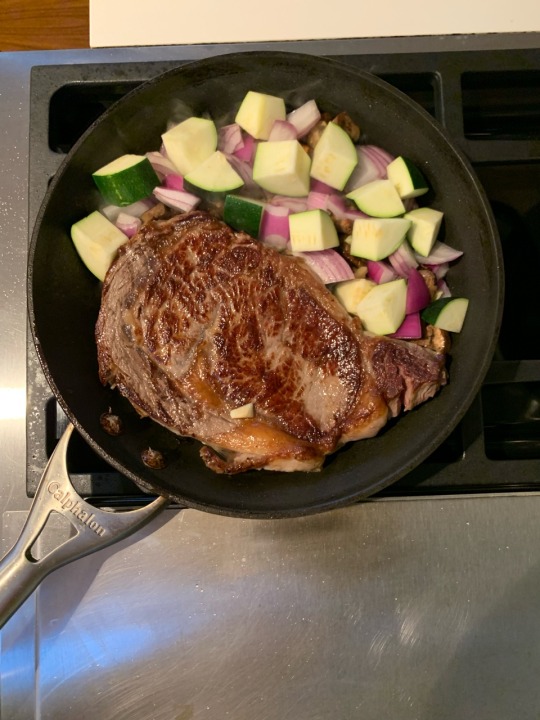
Take your protein out and put it with one portion of the veggies in a microwave safe container. That's going to be your lunch tomorrow. Put the other portion of protein on a plate to rest (you have to let a cooked protein sit a couple minutes before you serve it or when you cut into it all the juices run out and it goes dry - the liquids thicken as it cools, preventing this drying out if you let it rest, the goal is to serve it very warm but not hot hot)
While it's resting, pour some sauce from your bottle in the pan with the rest of the veggies and turn up the heat. A single sauce/bottle is fine, i like to get fancy and mix a couple. Two examples of personal favorite mixes are 1: bbq sauce and a hot sauce like sriracha 2: roughly equal parts low sodium soy sauce and worcestershire (makes something similar to a teriyaki sauce) A swallow of wine is almost always a great option if you want to add that to your sauce too, just add it to the pan before the other sauces so the alcohol has time to burn off.

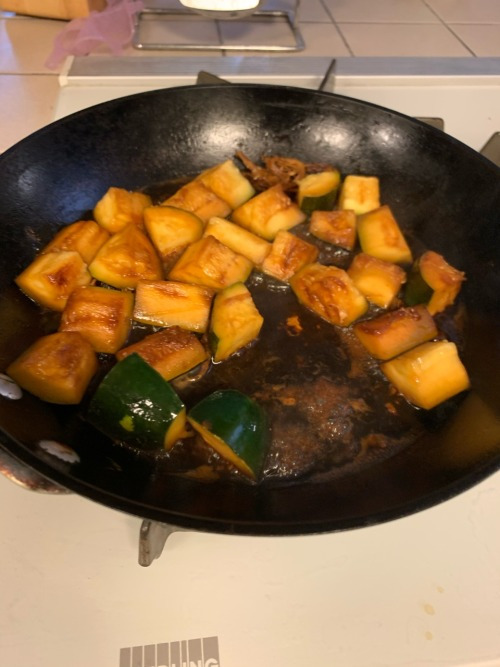
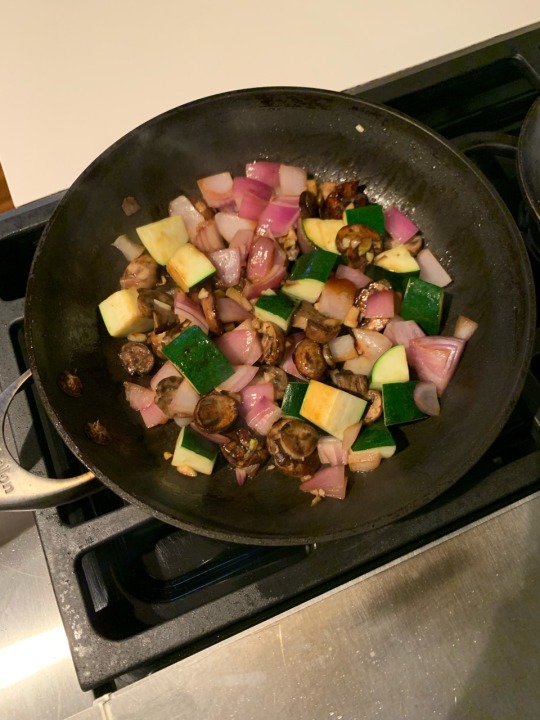
...
Here is the important bit. While your veggies are finishing, wash your cutting board and chef knife. Then when you dump your veggies and sauce over your protein on the plate, while it is still too hot to eat, you wash your frying pan and spatula before you eat. Now the only dishes you have left to do are your plate and fork. Maybe a steak knife.
...
The whole thing takes about 35 minutes even with washing the dishes, and that includes your lunch for the next day- just pour a different sauce on and stick it in the microwave for a couple minutes (or five minutes back in the frying pan) and you have a full healthy lunch with a different flavor
You can use this technique every single meal and it yields hundreds of combinations, from pork and potatoes bbq, to salmon and broccoli teriyaki, to chicken and zucchini in a soy glaze.
It will keep you down to less than an hour of kitchen time per day total for both lunch and dinner including all dish clean up, uses the least dishes, the least effort, requires the least technique, and is, depending on what you pick out, very affordable
here are a couple more examples from this month; i didn’t take pictures of the salmon i did recently, but you get the idea
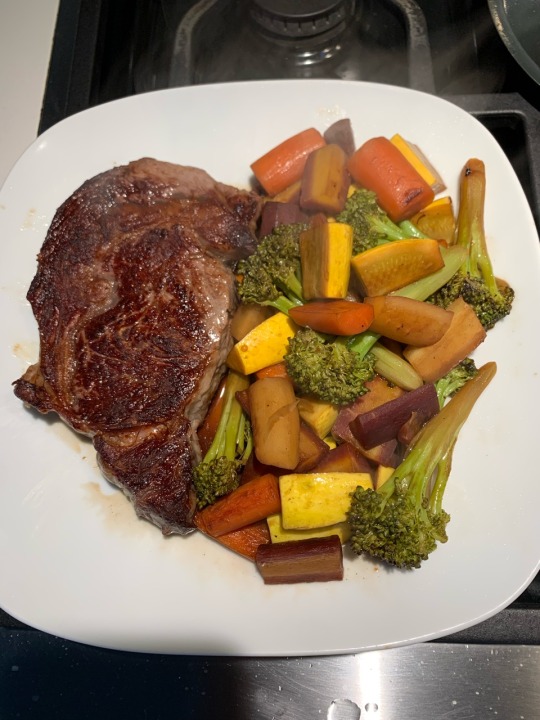
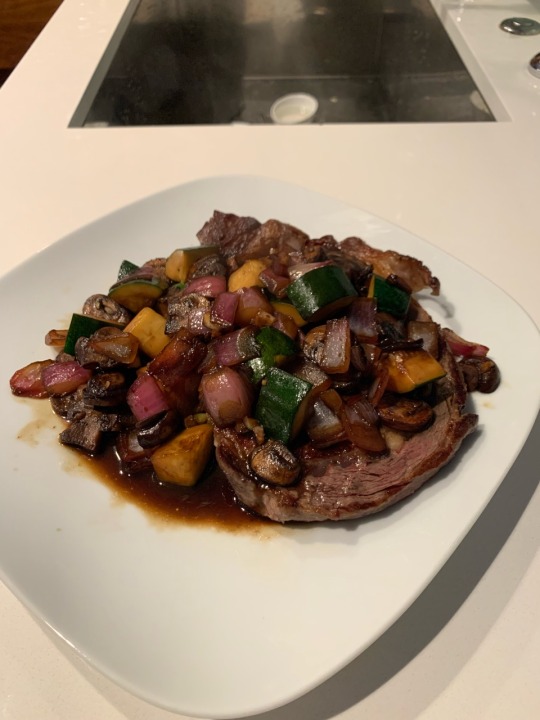
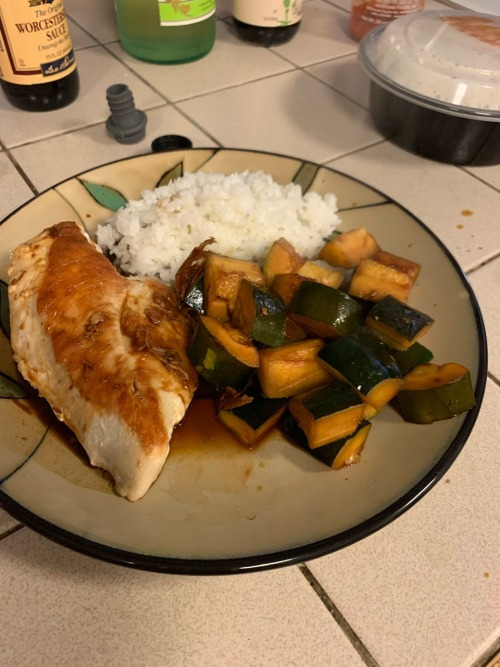
it's not super fancy, but it is easy, affordable, quick, and any flavors you want. Hope this helps some folks
Happy Cooking!
25K notes
·
View notes
Text
Mastering Blood Sugar Control: Strategies for a Healthier Life
Maintaining stable blood sugar levels is crucial for overall health and well-being. Fluctuations in blood glucose can lead to a range of health issues, from fatigue and irritability to more severe conditions like diabetes. Here’s a comprehensive guide to mastering blood sugar control through diet, exercise, and lifestyle changes.Understanding Blood SugarBlood sugar, or blood glucose, is the amount of glucose present in the blood. It’s a primary energy source for the body, but maintaining it within a healthy range is essential. Blood sugar levels are influenced by the food we eat, how we exercise, and various physiological factors.1. Balanced DietA balanced diet is the cornerstone of effective blood sugar management. Focus on these dietary principles:Choose Low Glycemic Index Foods: Foods with a low glycemic index (GI) release glucose slowly into the bloodstream, helping to maintain stable blood sugar levels. Examples include whole grains, legumes, and most vegetables.Incorporate Fiber: Fiber slows the absorption of sugar, which helps in controlling blood glucose levels. Opt for fruits, vegetables, whole grains, and legumes.Control Portion Sizes: Eating large portions can lead to spikes in blood sugar. Use smaller plates and be mindful of serving sizes.Limit Sugary Foods and Drinks: Reduce the intake of foods and beverages high in added sugars, like sodas, candy, and baked goods.2. Regular ExercisePhysical activity is vital for blood sugar control. Here’s how exercise helps:Improves Insulin Sensitivity: Regular exercise makes cells more responsive to insulin, which helps in managing blood sugar levels.Aids in Weight Management: Maintaining a healthy weight through exercise can improve blood glucose control and reduce the risk of developing type 2 diabetes.Enhances Overall Health: Exercise supports cardiovascular health, reduces stress, and boosts mood.Aim for at least 150 minutes of moderate-intensity exercise per week, such as brisk walking, swimming, or cycling.3. Consistent Meal TimingEating meals at regular intervals helps in stabilizing blood sugar levels.Don't Skip Meals: Skipping meals can lead to blood sugar drops or spikes. Aim to eat every 3-4 hours.Balanced Meals: Each meal should include a mix of carbohydrates, proteins, and fats to provide a steady source of energy.4. Stress ManagementChronic stress can affect blood sugar levels. Incorporate stress-reducing techniques into your routine:Practice Relaxation Techniques: Techniques such as meditation, deep breathing, and yoga can help manage stress.Get Adequate Sleep: Aim for 7-9 hours of quality sleep per night to support overall health and blood sugar regulation.5. Monitor Blood Sugar LevelsRegular monitoring helps you understand how different foods and activities affect your blood sugar levels.Use a Glucometer: Track your blood sugar levels as recommended by your healthcare provider.Keep a Log: Record your blood sugar readings along with information about your diet, exercise, and any symptoms you experience.6. Seek Professional GuidanceConsult with a healthcare provider or a registered dietitian to create a personalized blood sugar management plan. They can provide tailored advice based on your specific health needs.ConclusionEffective blood sugar control is achievable through a combination of a balanced diet, regular exercise, consistent meal timing, stress management, and diligent monitoring. By adopting these practices, you can maintain stable blood sugar levels and support your overall health. Remember, individual needs may vary, so working with a healthcare professional is essential for developing a plan that works best for you. Blood Sugar Control: Strategies for a Healthier Life
#Maintaining stable blood sugar levels is crucial for overall health and well-being. Fluctuations in blood glucose can lead to a range of hea#from fatigue and irritability to more severe conditions like diabetes. Here’s a comprehensive guide to mastering blood sugar control throug#exercise#and lifestyle changes.Understanding Blood SugarBlood sugar#or blood glucose#is the amount of glucose present in the blood. It’s a primary energy source for the body#but maintaining it within a healthy range is essential. Blood sugar levels are influenced by the food we eat#how we exercise#and various physiological factors.1. Balanced DietA balanced diet is the cornerstone of effective blood sugar management. Focus on these di#helping to maintain stable blood sugar levels. Examples include whole grains#legumes#and most vegetables.Incorporate Fiber: Fiber slows the absorption of sugar#which helps in controlling blood glucose levels. Opt for fruits#vegetables#whole grains#and legumes.Control Portion Sizes: Eating large portions can lead to spikes in blood sugar. Use smaller plates and be mindful of serving si#like sodas#candy#and baked goods.2. Regular ExercisePhysical activity is vital for blood sugar control. Here’s how exercise helps:Improves Insulin Sensitivi#which helps in managing blood sugar levels.Aids in Weight Management: Maintaining a healthy weight through exercise can improve blood gluco#reduces stress#and boosts mood.Aim for at least 150 minutes of moderate-intensity exercise per week#such as brisk walking#swimming#or cycling.3. Consistent Meal TimingEating meals at regular intervals helps in stabilizing blood sugar levels.Don't Skip Meals: Skipping me#proteins#and fats to provide a steady source of energy.4. Stress ManagementChronic stress can affect blood sugar levels. Incorporate stress-reducing#deep breathing#and yoga can help manage stress.Get Adequate Sleep: Aim for 7-9 hours of quality sleep per night to support overall health and blood sugar#and any symptoms you experience.6. Seek Professional GuidanceConsult with a healthcare provider or a registered dietitian to create a perso
0 notes
Text
Doctors truly will be like “Don’t eat fatty foods which include *proceeds to list every food that exists*”
#no most people can’t live on fruits#do you know how many apples you’d have to eat a day in order to fulfill your daily requirements just for energy#not even mentioning protein or fats (which yes you do need some fat)#at least *21* apples#I don’t know anyone with enough patience and jaw muscle to eat that many apples#I mean even one apple gets exhausting to eat before I’m finished I couldn’t have 7 for every meal I think my maximum might be 5 per day#but doctors also think you shouldn’t have sugar so apples actually are out of the question#and so are carbs in general#we are now out of foods that exist#I guess ‘lean protein’ is left but salt is bad for you#and I don’t really want to eat unsalted boiled chicken tbh#I guess vegetables don’t count as carbs but all the edible ones have sugar#and lettuce is even harder to eat than apples
0 notes
Note
Tim do healthy things in unhealthy ways
you need to do this to be healthy? Well he is only gonna do that exact amount
only 8 ounces of water grace his body a day
8 hours of accumulated sleep through 10-30 min naps
the exact medically necessary physical touch
etcetcetc
Tim pulling up research papers and stalking all of his loved ones to make sure they are getting the minimum amount of things to be healthy (while also fulfilling his minimum amounts).
He's got research papers, but he also adjusts per need. For example, Dick requires more physical affection than most of the other Bats. Therefore, Tim ensures someone is administering regular physical contact even if that's him.
Just Tim, his charts, and his stalking as a form of love. Him informing Alfred when someone needs more vegetables or protein in their diet. Him not so subtly nudging Bruce to use more words of affirmation. Him sneaking meals into Jason's safehouses, Dick's apartments, the Clocktower, or where ever Cass is.
Babs and Alfred are fully aware of the extent that Tim goes to for everyone. Dick has most of an idea, and Bruce has some of an idea.
YJ are the only ones who know Tim's unhealthy system for himself ("Tim! You need 8 hours of sleep consecutively!" "At least I'm getting 8 hours!")
500 notes
·
View notes
Text
i was reading the recipe suggestions on some of the cans of mackerel i have in my cupboard, and I've noticed that on all of the recipe suggestions for pasta, seafood, anything really say "try this for a low-calorie, low carb, low fat, low sugar dinner". you. need those things when it comes to be mealtime. calories are a measure of how much "energy" you can burn, not how much weight you will gain from eating the food. carbohydrates get broken down into starches, sugars, and fibers, which are all necessary for you to function.
your brain & body operate primarily off of fats, sugars, and proteins, but i've noticed that protein is the only thing we push as absolutely necessary, which just isn't true. whenever you idle and not in motion, your body has nothing to do with the extra protein you're bringing in. it will be stored as extra fat if you do not give that protein a reason to build muscle tissue instead.
your brain consumes 20% or more of the sugar you take into your body- our brains NEED glucose, you literally need sugar to think. if you feel depressed and like you're sluggish reacting to things, thinking, remembering things, and other mental processes, if you are the kind of person who refuses to eat any sugar at all due to wanting to be skinny, you are doing your brain a huge disservice:

i can't stand the hatred towards dietary fats, because it's causing so many people to be outright miserable or even sick. you need fats to function. they are an excellent source of energy and are literally required for you to be able to move, think, and combat disease. they are not this icky thing that you need to avoid at all costs. fats are extremely important for brain development, as well as brain function, and even immune system function:

also for many people, 2,000 calories or less per day is nowhere near enough. your brain actively consumes calories, fats and sugars while you are awake, no matter what you are doing:

i sincerely refuse to believe that if JUST YOUR BRAIN ALONE consumes somewhere in the ballpark of 400-500 calories just for being awake and active that we can only survive off of 2,000 calories a day. capitalism, diet culture and fat shaming forcing us to starve ourselves of vital nutrients so we are weak and too tired to fight back against the bullshit we face every day. food is important.
food isn't just to satiate the feeling of an empty stomach. it is the ONLY way you get vital fuel in order to keep moving, living, thinking, and breathing. vitamins and minerals are NOT the only vital aspects of food. you're not meant to restrict how many nutrients you get at FUCKING MEAL TIMES. YOU NEED FUEL. PLEASE FUEL YOUR BODY AND BRAIN. A CONVENTIONALLY ATTRACTIVE BODY ISN'T WORTH SUFFERING AND LIVING YOUR WORST LIFE!!!!!!!!!!!!!!!!!!!!!!!
#punk#trans punks#trans punx#queer punks#queer punk#cripple punk#crip punk#cpunk#cripplepunk#disability#disabled#actually disabled#humanitarian#humanitarianism#health#our writing#fat liberation#body image#fat lib#body liberation#bodily autonomy#body autonomy#weight#food mention#diet culture#physical health#fuck diet culture
909 notes
·
View notes
Text
HEALTH SHOULD ALWAYS COME FIRST! PRIORITISING HEALTH BEFORE EVERYTHING ELSE TO LOOK GOOD + FEEL GOOD.

People always leave out the basics when it comes to trying to improve their looks. Prioritising health is so important before going in and tempering with your body. Your base is what you work with and you can definitely level up with what you've got naturally.
DIET
Your diet also depends on what your goals are. Someone who wants to build muscle will obviously eat differently from someone who just eats relatively healthy. So identify what your goals are and work your meals around that.
Here are some videos to give you a better insight: HOW I LOSE FAT AND KEEP IT OFF MEANS, WORKOUTS + EVERYTHING ELSE PROTEIN EXPLAINED, STRENGTH, MUSCLES, FAT LOSS & ENDURANCE HOW METABOLISM WORKS
Diet not only makes you feel better from the inside, but it also reflects on your outside. Your skin is a huge display of how you eat.
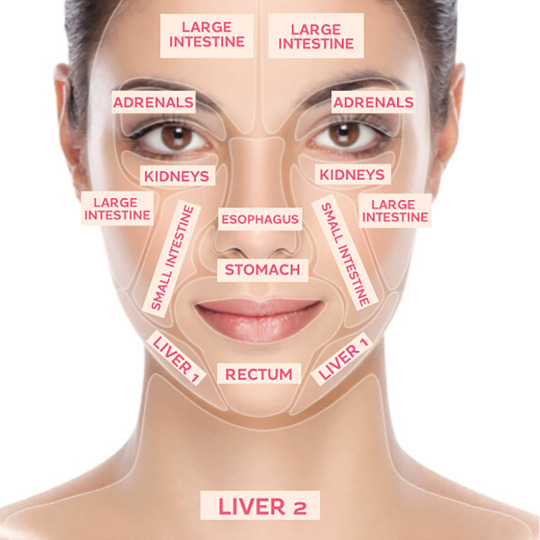
When you consume junk food, it can show up on your skin as breakouts or dullness. Your skin is one massive organ which soaks up everything put onto it and reflects everything you put inside your body. Fix the problem from the inside before getting confused about why your skincare routine isn't working.
FITNESS
Again, your fitness will differentiate from your goals. So work out your goals and make a plan around that. There are so many forms of fitness, some more intense than others and with different results. Working out in general is good for you, our bodies are meant to move. So even if you don't have a goal, staying active is always recommended.
HOW TO CREATE THE PERFECT WORKOUT PLAN
THE BEST WAY TO GAIN MUSCLE, SCIENCE EXPLAINED SIMPLY
Low-intensity workouts:
Yoga: Focuses on flexibility, strength, and relaxation through various poses and breathing techniques.
Pilates: A low-impact exercise method that strengthens muscles, improves flexibility, and enhances posture.
Walking: Simple yet effective, walking is a great way to improve cardiovascular health and boost mood without high impact.
Swimming: Provides a full-body workout with minimal stress on joints, making it ideal for people with joint issues or injuries.
High-intensity workouts:
HIIT (High-Intensity Interval Training): Alternates between short bursts of intense exercise and brief recovery periods to maximize calorie burn and improve cardiovascular fitness.
CrossFit: Combines elements of weightlifting, interval training, gymnastics, and other exercises to build strength, endurance, and overall fitness.
Sprinting: Short, explosive bursts of running at maximum effort, often performed in intervals for cardiovascular conditioning and leg muscle strength.
Circuit Training: Involves moving through a series of exercises targeting different muscle groups with minimal rest in between, combining strength training and cardiovascular exercise.
These are just a few examples, but there are plenty of other workout styles out there to explore depending on your preferences and fitness goals. Walking every day is just a simple way to stay toned.
SLEEP
Sleeping is important for rest and recovery after workouts and energy-consuming activities. Sleep is needed for the brain to function, mood regulation and performance + productivity. Lack of sleep deprives you of all of these things, so getting your beauty sleep is absolutely needed.
School-age children (6-13 years): 9-11 hours per day.
Teenagers (14-17 years): 8-10 hours per day.
Young adults (18-25 years): 7-9 hours per day.
Adults (26-64 years): 7-9 hours per day.
HYGIENE
Upkeeping good hygiene is always needed anyway. Making sure you are clean (smelling good is a plus). Make sure you always wash your hands and take daily showers to remove any dirt on your body (clean those feet and your back well, don't forget them!). Taking care of your oral health must not be forgotten. Oil pulling and brushing your tongue for a healthy mouth. Make sure your hair is also getting the attention to keep it as healthy as you possibly can make it (this also depends on diet). Doing the extra things like spending time on your nails (making sure there isn't that stuff underneath them), making them pretty.
BODY CARE ROUTINE | FOR SMOOTH & GLOWING SKIN, TREATING KERATOSIS PILARIS, SHOWER ROUTINE
ENVIRONMENT
Having a stress-free environment is obviously the best to thrive in. But clearly not even being lucky enough to live like that constantly. So make sure you have that space to be on your own and have some alone time to really recharge. Keeping your space clean for a clear mind. Surround yourself with like-minded people and really set boundaries for those who prey on your mental clarity (energy vampires). Spending time in nature is one of the best ways to detach, rest time should not equal spending time on your devices. Let go and truly let yourself decompress. Mental health will improve how you carry yourself.
EMBODY YOUR POTENTIAL.
1K notes
·
View notes
Text
365 Days from Rot to Hot.
Increase walking, add Mat Pilates and stretching to your routine, begin light cardio and weightlifting, and do your best to hit 10,000 steps per day whilst still doing an additional activity on top of that. Walking, doing light weights, heavy cardio, Mat Pilates, and stretching made my body look amazing after losing 80+ and growing into my shape as it is today.
You need to increase your water intake as well as your protein intake. The most important thing I learned on my journey was that I needed to be eating and drinking if I wanted to see any progress. Calories, when used well, aren’t anything to be afraid of. Introducing whole foods, good meals, and proper nutrition into my life changed things for the better almost immediately. I also began drinking half my body’s weight in ounces, and the weight just fell off.
Skincare (including exfoliation, deep moisturizing treatments, sun protection, etc.) is essential. Taking care of your whole body, not just your face, is incredibly important. I take the time to care for my whole body as well as my face, and I don’t ever neglect myself. I’ll refrain from making a long list of the things I do, but I will say this: your skin is your body’s largest organ, and if you are unhealthy or neglectful, it will deteriorate and make you look much older.
Your environment is a reflection of yourself. You cannot expect to look pristine if you keep a filthy home. Tidy your room, wash your clothes weekly and hang or fold them the moment they come out of the dryer, wipe your shoes clean from scuff marks, and organize your makeup and other possessions. I take a lot of pride in how organized I am and how beautiful I’ve made my home, and part of that beauty has to do with my willingness to clean and take care of my things.
The most important part of bettering yourself is recognizing that you can and should be doing better. I’ll be the first to admit that there have been times where I’ve slipped up, but what’s helped me move forward without guilt or shame is knowing that I can think to myself, “I can do better,” and keep going. Life is going to feel meaningless if you don’t give yourself grace. In order to grow and eventually find yourself in the place you want to be, you have to recognize that doing better today than you did yesterday is an essential part of human growth and maturation.
Pt. 2 to come next.
#hypergamous heaux#hypergamy#leveling up advice#leveling up tips#hypergamy advice#hypergamy tips#hypergamous woman#black women in leisure#black women in luxury#spoiled black women#spoiled gf#spoiled girlfriend#leveled up black woman#leveled up woman#leveling up journey#leveled up mindset#leveling up#hypergamous mindset#hypergamy journey#hypergamous#vindicta#diabla#splendida#becoming an it girl#becoming her#becoming that girl#high society advice#high society tips#black femininity#social climbing
640 notes
·
View notes
Text
custom 75 hard challenge






daily rules
workout
exercise every day for at least 45 minutes (any form of movement).
rest day: i’m allowed one full rest day per week from strenuous activity.
flexibility training
stretch or do flexibility training every day for at least 15 minutes.
rest day: i can take one day off flexibility training per week if needed.
intermittent fasting
follow intermittent fasting from 12 pm to 6 pm or 12 pm to 8 pm, depending on how i feel that day.
drinks allowed during fasting:
green tea (or really any tea)
coffee
chia + lemon water
protein smoothie (only if i’m really hungry)
clean eating
eat healthy, clean meals every day, minimising carbs, sugar, and greasy foods.
incorporate more plant-based or vegan meals into my diet.
cheat meal: one cheat meal is allowed per week to support calorie confusion.
study
study everyday even if it's just 20 minutes
focus on either uni coursework or learning german.
vitamins
take the following daily supplements:
women’s probiotics
women’s multivitamins
b12
iron (every second day)
hydration
drink at least 3–4 litres of water daily to support energy and recovery.
sleep
prioritise getting at least 8+ hours of sleep every night to recharge and support my body.
clean and tidy
take time every day to clean and tidy my space, keeping my environment organised and comfortable.
reading
read at least 10 pages of a book every day (any genre). audiobooks are okay if reading physically isn’t possible.
additional rules
period flexibility
i can adjust or skip rules as needed during my period, prioritising listening to my body.
blog
write a blog post every day to document my progress, or any inspiration posts.
challenge duration
75 days, with all rules in effect unless noted for flexibility.


#75 hard#75 soft#75 medium#self care#healthyliving#healthylifestyle#healthy food#healthy weight loss#weight loss#weight loss diet#healthy eating#healthy girl#lose weight fast#workout#vs angel#it girl#flexibility#healthyhabits#mental health#health & fitness#flexible#pink pilates princess#victoria secert model#intermittent fasti#fitness#girlhood#victoria secret#beginner workout#glow up#it girl energy
246 notes
·
View notes
Text
The rules for the healthy girl June 🥦💐💪🏻
I thought I would tell you guys the rules before hand just so you had time to prep especially if some of you are working or have different obligations.
Rules for the entirety of June
Get at least 7hrs of sleep a night every night.
Drink a glass of water before each meal.
Move your body everyday for at least 30 minutes.
Eat a fruit or vegetable with every meal.
Only thing you should track in terms of what you eat is your protein intake try for at least 100 grams per day.
Track your progress in a way that’s healthy for you. This can be measuring this can be photos or the scale( I personally don’t use the scale because it is not healthy for me so I measure and take photos).
No fast food if you can help it (I know some of you are younger and might not have control over all your meals so still eat even if it’s fast food)
Three meals a day everyday so not skip meals.
These are our glow up rules I believe in you guys!!
#it girl#that girl#girlblogging#glow up#self care#coquette#self love#healthy#healthyliving#becoming that girl#becoming her#clean girl
1K notes
·
View notes
Text
Warrior Bites: Dietary Needs
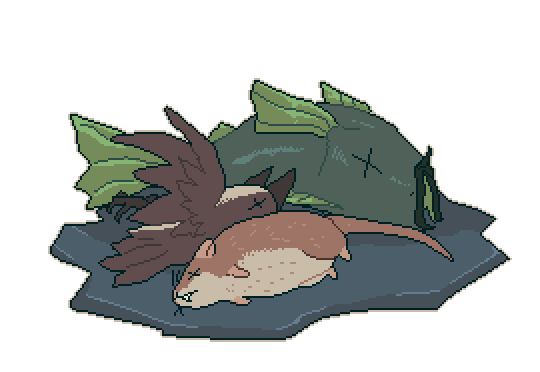
[ID: A fish carcass, bird carcass, and mouse carcass on a stone slab.]
Are you wondering how much prey a Clan needs a day? What they should eat to stay healthy? Why food processing is useful at all? All the answers to these questions and more, contained within a general guide to dietary needs for your Warrior Cats!
As an obligate carnivore, a cat's entire diet revolves around processing meat. More specifically, the ideal diet should be 55% protein, 45% fats, about 1% to 3% carbs, with the remainder being various micro-nutrients. You can expect the average 10-pound warrior to need 350 calories per day, about 3.5 mice on average.
I've also included a section talking about obesity, which dives into how canon's depiction of it is both harmful fatphobia and wouldn't make sense from a cat perspective. It also discusses obesity in realistic cats; and how you're free to choose the realism on that aspect.
Below the cut;
Caloric Intake
Nutrition
Food Processing
On Obesity
Caloric Intake
The general rule for how much a cat needs to eat is that an active, non-neutered tom will need about 35 calories per pound of their own body weight, per day, just to remain the weight they are.
That means that the average warrior, assuming they are 10 pounds, will need 350 calories a day.
Kittens, pregnant and nursing cats, and large warriors will need to eat more than average. Neutered cats, elders, and clerics/medcats will eat less. There are calculators online for determining how much an individual will need, but you can estimate how much an entire Clan will need just by taking 350 and multiplying it by population!
Assuming the average population is about 30 cats, that's 10,500 calories to feed a Clan for a day! To put that in perspective, that many calories would feed 7 large humans. If you felt like fighting a group of angry cats to steal their day's worth of mice, I mean.
Generally speaking, land prey will have a caloric value around 5 calories per gram. Aquatic prey is significantly lower, around 4 calories per gram. Birds will be just below 6 calories per gram. To find out how many cats a piece of prey will feed, or how many pieces a cat will need that day, take the category and multiply by the prey's weight in grams.
So for example, the average house mouse is 20 grams and it is land prey, meaning its caloric value is around 100 calories! A warrior will need 3 and a half mice a day to stay healthy, and a Clan will need 105 mice daily to support 30 cats.
105 mice may seem like a lot, but remember that a wild rabbit is 1,800 grams on average which means 9,000 calories. 2 big pieces of prey will feed the whole Clan, with leftovers.
Those estimates include every part of the animal. Cats eat organs, small bones, and even skin. Skeletal muscle, or "fillets" in reference to fish, is so low in calories that it's typically somewhere between 1 kcal to 1.5 kcal per gram. That's what you're buying in the supermarket; but wild animals don't usually cut their food into choice strips.
(unless you're writing a clan that does food processing of course!)
QUICK FACTS
Average warrior will need 35 calories per pound of weight
10 pound warrior needs 350 calories a day
350 x 30 cats = 10,500 calories to feed a Clan for a single day
Birds provide the most calories per gram, land prey the middlemost, and aquatic prey the least.
Calculate calories in prey by taking the weight, converting to grams, and multiply by 4, 5, or 6 depending on broad category.
If you're having trouble feeding a Clan on small animals, look at bigger prey like rabbits and trout.
Muscle fillets are inferior to organ meats and have a much lower caloric value.
Nutrition
Not all food is the same. The more important thing to consider about any particular meal is NOT its calorie count, but its nutritional value. This is especially important to cats because protein is not stored as fat. If the body has no immediate use for it, it's flushed out.
Since cats should not eat more than 3% carbs, ALL of their fat stores will need to come from fat.
The ideal piece of meat would be at least 55% protein and 45% fat. Every individual species will have a different ratio, and more importantly, individual cuts will have a different ratio.
Skeletal muscle has a higher ratio of protein to fat. Organ meat, also sometimes called "offal," will have a more balanced ratio. That said, nearly all meat skews towards protein. PURE fat is very hard to find on the sorts of animals Clan cats hunt, and must be carefully divided, collected, or processed to make sure all warriors are getting proper nutrition.
I'll be going more in-depth with dietary fat at some other time, as this guide is meant to just be an overview! Just know that some Clans will need to eat MORE food to stay healthy because of this.
Cats need more than the "macronutrients" to stay healthy. They can't JUST rely on the juiciest cuts of meat to keep their health intact, they also need several vitamins and minerals to support their body functions, and avoid getting a deficiency.
Here's some of the important micronutrients, where to get them, and what happens they don't get enough;
Vitamin A: Livers, mealworms, eggs This is one of the most important micronutrients in a cat's body, used for practically everything. Without this, their coats will grow dull, and their joints stiff, and they'll start to go night-blind. In a severe state, they'll start to lose the ability to heal skin lacerations and die. Pregnant cats and kittens need more of this than usual, but it IS also possible to get vitamin A poisoning from getting too concentrated of a dose.
Calcium: Bones, eggs With a calcium deficiency, the warrior will feel stiff and sore, and experience painful muscle spasms. Most cats will simply crunch the bones of small prey and never have to worry about this, but if your cats cook or scavenge, they have to be told to NEVER eat the bones of a roasted bird. Because bird bones are hollow and cooking makes them brittle, they can splinter and cause fatal internal bleeding.
Thiamine: Trout, boar meat, mealworms, eggs Called a Fish Seizure because raw carp and raw bream contains thiaminase, which will destroy thiamine in the body. Lack of thiamine will cause neurological issues, such as the aforementioned seizures, general confusion, memory loss, and muscle weakness. This can be counterracted by eating trout, which is so high in thiamine that there's a theory that carp evolved it specifically to eat salmonids better.
Potassium: Trout, boar meat, mealworms, eggs As cats get older, they begin needing a lot more potassium for their bodies. It's a very common micronutrient found in most meat, but elders should get the first bite of special snacks "out of respect" which helps keep their potassium level up. Without it, they become very weak.
i feel like that evil struthiomimus from land before time with how many times i typed eggs
QUICK FACTS
The ideal ratio of a cut of meat is 55% protein 45% fat
Organ meat > Muscle meat
Micronutrients are important
But micronutrients can also cause poisoning if, somehow, they're too concentrated (very hard to come across concentrated micronutrients without the science of chemistry tho. Like if a cat swallowed a vitamin gummy.)
Food Processing
"Food Processing" is when you do something to your food before you eat it. Just a little bit of care is going to go a LONG WAY when it comes to health of the warrior.
Cats that eat raw meat the way canon warriors do are almost guaranteed to get worms. Roundworms, hookworms, and tapeworms are all passed through the infected tissue of rodent prey, and in fish, roundworms, tapeworms, and flukes can pass through raw meat.
All parasites do something a little different, but most digestive worms aren't fatal unless the cat is sick or a kitten. However, nearly ALL of them screw around with digestion, making the cat need to eat more just to stay healthy, or causing stomach irritation. Some of them can even pass in milk, infecting a suckler's nursing kits.
The easiest way to reduce this kind of infection is simply to slice the prey open from mouth-to-butt, Tigerstar-style, and hook and lift out the GI tract before eating. There's nothing in that worth eating raw anyway. It can just be discarded, or cleaned out and used to case tiny sausages! But it's only a reduction; there's still a risk of catching worms from raw meat.
There's also always the possibility of getting salmonella poisoning.
Many believe that cats are immune to this, but that's not true! Carnivores just have a shorter GI tract than omnivores and herbivores, so salmonella spends less time in their gut and ergo has less chance of causing an infection. It still happens, ESPECIALLY when cats hunt songbirds.
Nothing can be done about salmonella in raw meat, besides eating it as quickly as possible. It's innate to the bodies of birds and reptiles, and usually found on raw eggs too.
Some animals are small enough to be dried and carried around as rations, such as minnows or grasshoppers. Others could be sliced up into strips, and marinated in spices like valerian or catmint for an extra boost of energy. It could also be worthwhile to cut the pelt off a particularly soft animal, like a mole, to dry and keep as bedding material.
All of the above examples of food processing are possible without fire, but if your cats DO have fire, they will have a DRASTIC increase to the quality of their health.
Such as;
Cooking will almost completely eliminate those foodborne parasites. Their eggs don't survive extreme heat.
No more salmonella poisoning! GONE! Cooking is the only way to eliminate this!
It can increase caloric absorption from anywhere between 20% to 50%. Our example warrior who needed 3.5 mice a day could suddenly need one less mouse; and even a meager 20% drop in how much the entire Clan needs saves 2,400 calories a day. 24 whole mice!
I HAVE TO STRESS HOW BIG THAT IS. You save anywhere from 2/10 to 5/10 successful kills.
Thiaminase is destroyed by cooking, making bream and carp healthier and reducing "fish seizures."
It allows for fats to be processed and stored as tallow, lard, and oil, so it can be added to other dishes to make them both healthier and tastier.
Most food preservation requires fire in some way; by heating, jellying, boiling, etc. The only other two ways to reliably store food is by having access to a ton of salt, which is hard for most non-coastal clans to acquire, or vinegar, which is so acidic it's a notorious cat-repellent.
While cooking can also destroy some micronutrients, its benefits FAR outweigh any potential "strengths" of raw food. Destroying micronutrients is also not always a bad thing; as TOO MANY micronutrients can cause poisoning. Fire-using Clans will be more likely to "seek" micronutrients than non-fire Clans as a result, though they probably won't recognize the science behind a hankering!
QUICK FACTS
Worms. Basically unavoidable if your cat's eating like a canon warrior.
Some parasites can spread through milk.
Slicing and lifting out the GI tract can significantly reduce the chance of catching worms.
Salmonella can only be eliminated with cooking
Cooking will drastically increase the quality of a Clan's health, if your cats are advanced enough to figure out fire.
Warriors need to hunt a LOT less prey, and can store that prey, if they have fire.
Fire-using Clans will intentionally try to put more types of food in their diets and get 'cravings.'
On Obesity
Warrior Cats is not a realistic series. The boundary that any particular writer draws between humans and warrior cats is completely arbitrary. The series itself follows no sense of realistic genetics, regularly shows the cats using herbs that would poison them, and gives the characters human-centric morals like monogamy and paternal involvement.
So when it comes to being fatness in your project, please keep that in mind. You do not need too follow realistic cat weight distribution, if that's not what your project about. That said, let me tell you about humans vs cats in this department!
Humans have a massive diversity of weight distribution, with varied genetic predispositions to gaining and losing weight. The shame, bullying, and medical discrimination that comes with fatphobia is a LOT more harmful than being fat itself, and the causes of the "obesity crisis" are ridiculously more complicated than "ppl r snorking 2 much food".
Realistic cats aren't the same way.
When REAL cats are fat, that's VERY bad. It's a sign they are being fed the wrong things by humans, or live somewhere that they are able to eat what they shouldn't. They just don't have that same diversity in fat distribution that humans do. Because of how adipose tissue secretes certain hormones, feline obesity is like a chronic inflammatory disease which can cause arthritis, bladder stones, hepatic lipidosis, and more.
But with that in mind, fatness should be perceived very differently even in the most realistic settings. In comparison to humans;
It is harder for a wild cat to put on weight. Most of what they're eating is raw protein, actively trying to fill the 45% of daily fat intake they need to stay healthy. Protein isn't stored as fat, it's immediately discarded by the body if there is no use for it. A cat would need to be taking an INSANE amount of prey to start becoming dangerously overweight. Housecats are often fed human food, which has carbohydrates. Low-quality cat food will also use carbs as filler. High carb food is VERY bad for them, since they're only supposed to have 3% carbs at most. This is one of the reasons why it's easy for pet cats to become overweight.
Realistic cats don't look start looking overweight until they are significantly obese. Most of their fat is stored around their ribs and internally, unlike humans with our thick hips and round bellies, and they are covered in a naturally sagging pelt of fur. It's not as obvious with them. Visually, weight will be noticed best from a bird's eye perspective, unlike humans where it's apparent at every angle.
Putting on the fat that CAN be acquired is ridiculously important 3.5 raw, whole mice a day, per cat, are needed to fill their basic dietary requirements. There are going to be days or months especially during winter where they might be below that number, and that stored fat is going to be lifesaving. Bulking up is actually a big deal!
So not only is how canon treats overweight characters full of malice, it's full of lazy malice. It makes no sense from a realistic standpoint for wild cats to develop an association between fatness and greed or laziness. It's important, hard work for them to acquire it!
Though the Clans are notoriously xenophobic and kittypets are more likely to be overweight, it still doesn't make sense from a realistic cat perspective to be fatphobic in the same way as canon. It's more likely they'd see fat housecats as having "unearned" weight given to them by humans, like they're cheating, or they might be disdainful of how much junk food they eat, or pitiable because it's a sign of a bad twoleg... or just "sour grapes" variety jealousy ☕.
Bottom line is that there's a LOT you can do here which is better than canon's vicious bullying. The writers just lifted British cultural disdain for fat people and put it into the books. They simply did not think it through.
So please do what they didn't, and just put a little extra thought into how your project is going to view fatness! Consider if fatphobia is even a theme you need in your text.
As stated, you do not even have to write weight in your cats as being realistic in this way! I encourage you to pick and choose what's most fun and fitting for your own work. I personally give my characters a more human weight distribution, simply because I want to spite canon and be more body-positive. I am a fat people and you can take Bumble's big chunky bod from my cold, dead hands.
You can choose to make your work however you'd like, and now with this guide, you can have an easy reference for what your cats should eat! Thank you, StarClan, for this prey <3
#Clan culture#warrior cats#Fatphobia#Cw fatphobia#tw fatphobia#Nutrition#Prey#Food#Bonefall's Clan Culture#Food guide#Nutrition guide#Gamer-the-kittypet art#Also if there are any devs or modders out there who wanted to add food values to any games that involve cats#Please feel free to use this guide as all my work is open-source#I can explain how I came to those values and work out some more accurate numbers if you end up needing them#animal death#cw animal death#tw animal death#cw parasites#tw parasites#parasites#Warrior bites
803 notes
·
View notes
Text
Food to feed the heart ᡣ𐭩ྀིྀི

ᡣ𐭩ྀིྀི relationships: simon riley x baker!reader
ᡣ𐭩ྀིྀི A/N: ello cuties i know i havent posted anything so take this before i post the next chapter (likely this weekend) because i also have exams next week which also means no chapter.. 😔
Part 1 | Prev | Next
A few days have passed since he had driven you back home from the farm, and you’re still a little flustered that you had fallen asleep so easily. It was embarrassing but thankfully he wasn't the one to wake you up; you’d probably pass out again if you opened your eyes to his skull mask in your face—no offense to him, of course. The truck jostled as he unpacked the car to take out all the fresh produce, clearly having no intentions of making you help. He handled it all with ease, feeling more like carrying a shopping bag than the heavy glass bottles of milk. “Simon?” Your voice has mumbled out sleepily, dragging your tired self around the side of the truck to watch as he lifted each crate. He had gone completely still at your words though, something shifting behind his eyes that were usually quite sharp, though it doesn't seem to be uncomfortable. That look alone flustered you and you immediately got to work despite his protests, hurrying to pack all the produce away.
You’ve long since closed the shop now, but you were preparing some dough as per usual. It was all you ever seemed to do these days, and even if more people were appreciating your bakes, you find yourself desperate for a new invention. Or well, at least somekind of new product in the shop. Somehow, your mind drifts back to your old train of thought that other day, what Simon would eat for lunch. You think he’d like something rich with flavour, considering how dry military food would be, but not spice—it doesn't look like he could handle that much anyway. Savoury seems to be his preference, even if he has tried a few of your sweeter options before. Don’t soldiers need lots of protein and carbs too? At least that’s what everyone says about building muscle, so you mentally jot those points down too. Your stomach rumbles as you see a notification from a cooking channel you follow, instantly clicking on it to see the thumbnail that is the most delicious tacos with their seasoned meat and vegetables. The video even showed pulled chicken tacos, but that’d seemed to be too messy for him to eat on the job— definitely a note for another day.
You hum as you lean against the counter, looking at the bread dough in the bowl before you. Pulled chicken sounded damn good especially for protein, you have bread already, and shredded vegetables would be easy to get…you're going to make the best damn meal he’ll have in his life.
——————————————————————
Sweat trickles down his back and soaks his shirt as he pants quietly, breaths eventually slowing down from his early morning run. The air is crisp, almost biting with how cold it is as December deepens. He doesn't particularly like how much his thoughts have shifted these days, always thinking about his next visit to his bakery rather than the rest of his schedule for the day. Damnit, just the mere sight of a teacup makes him think of your grin when you hand one to him. He’s convinced he’s starting to go insane.
The locker rooms are quiet at this time, and so he pulls off his top in one smooth motion before throwing in his laundry bag that he’ll handle later. His muscles flex as he stretches them a little, fishing out a fresh vest and shirt when his phone buzzes in his duffel bag. That’s unusual, no one really bothered texting him apart from his phone service provider or occasionally an app notification. Even Soap preferred to just hunt down the Lieutenant himself, knowing he barely ever checked his phone. But he does now, because now he’s got someone who has his number, and who actually wants to text him too. Your name and the silly picture you took on his phone flash up, and for once his thumb fumbles when he types his password in.
“Is there any chance i could potentially leave something for you at like.. a military gate.. post.. thing? You forgot something in the shop!”
He raises a brow at the message, knowing damn well he’s never been reckless enough to forget something that would be important as to be delivered to him at this time. If it really was something, surely it could wait until he inevitably saw you next week. At least, that’s what his rationale is telling him. He shouldn't breach work hours and go off and let you into the base, no he should just tell you that it isnt possible and he’ll handle it himself. He’d be damned if he ever let you drive your truck up here, carrying one of his things and delivering it to him personally. What if someone saw you? What if another soldier talked to you and you realised they’re the one you want to stay friends with and not him?”
At that he slams the locker door closed, letting out a deep breath and ignoring the way his face heats. It’s just because of the run, just because of the way his mask clings to his face. It’s really hot in here, yeah that’s it. This -2° air is boiling.
It’s almost lunch time now, and he walks down to the admin area where an intern, who is usually tasked with the mundane tasks like these, tells him there’s a girl waiting for him at the gate. He just gruffly nods, hands stuck in his pockets as he steps out of the building and where you stand on the other side of the barrier, awkwardly waiting with a little paper bag. He’s glad you’re wrapped up, a thick scarf practically engulfing your face and a wooly hat covering the hair he loves the look of. “Miss Lost and Found, is that your name now?” He hums, stepping towards you and you almost jump, not used to the physical skull mask he wears on base and rather the more tame chalk one. But his voice resonates instantly and you grin, tugging down your scarf to your chin. “I may have lied. I came bearing a delivery.”
Well he hadn't expected you to straight up lie to get your way, but he supposes it must be a good cause and so he takes the bag when you offer it to him, though not without taking your wrist too. “C’mon, let's get you warmed up inside.”
You’re not sure if you stick out like a sore thumb because of the thick jacket you wear compared to the camos sported around here, or due to the Lieutenant’s grip around your hand as he tugs you along. It must be a mix of both, assuming from the way the other soldiers look at Ghost and then you before scurrying off quickly. He eventually seats you opposite him in an office, letting you sit on the couch as he settles on the armchair. Though.. this office does not match him in the slightest. “Captain’s office, not mine.”
He hums, digging out the container out of the paperbag with curiosity along with a warm flask. “You didn't..” He grunts, eye flickering down at the food and then up to you, not quite sure just yet if the little lunchbox you brang is something he had somehow left behind in another life or you really had brought him lunch while he was working.
“I did. I wanted to thank you for all your help the other day” You grin, and he pulls off the lid, instantly caught in the delicious smell inside. Two large chicken stuffed buns right beside each other, practically still hot considering you cooked them this morning. Beneath is veggie sticks, ones you’d usually give to little kids, layered over seasoned rice in case he wasn't full on the buns already. And of course, would it really be you if you didn't give him a dessert? Of course, nothing too sweet, in fact you even went out of your way to make another off menu item for him… oops.
“Banana bread? Do you note down everything I say?” He likes the way your smile grows wider when he notices your efforts, taking care to remember that for later too. Though, he really is surprised you were paying that much attention to him. “You know I'm gonna devour this, righ’?”
Though you’re quickly cut off when the door bangs open, a noise common around here but not exactly for you since you unintentionally jump. It doesn't go unnoticed by Simon though, whose hand shoots out to protect before realising you had only jumped at the door and nothing actually serious. His hand says awkwardly hovering before you before he just picks some lint of your shoulder, quickly turning to the door instead. Is he going crazy or what? The cause of the noise was a bulky man who had almost as much muscle as the man in front of you, only shorter than him and the muscle was more evenly distributed.
“Lt, the fuckin’ rookies are at it again! This new batch are always fighting eachother!” He exclaims, walking over to the desk in the office to snatch a cookie out of a jar that easily blends into the rest of the furniture around. You stare at him as he bites into it, the crumbs falling onto his tactical gear before his head lifts to meet Simon’s, only to see you right in front of him. He raises a single brow at you, then chomps on a cookie a little more.
“Oh, is this one of ‘em? Lass doesn't even look terrified, have ye lost yer touch mate?” Ghost grunts as the man jests, and shakes his head before trying to move the lunchbox out of the man’s sight. “She’s not a soldier, Johnny.”
“Not a soldier eh? So.. CIA? One of Laswell’s right?”
“No”
”Medic?”
“No.”
“K9 Trainer?”
“No.”
”Damnit, Lt, yer killing me!”
‘Johnny’ groans as he steps around the desk, before promptly noticing the lunchbox that Ghost had failed to completely hide behind him. Though, that left even more questions unanswered. For starters, when has Ghost ever sat with someone for lunch?
“None of ya business who she is. I’ll deal with the rookies in five, just get ‘em rounded up, Soap.” Then he turns to you, wrapping the scarf that was tossed to the side back around your neck before he pulls you up by your hands. “And you need to get back home.”
“Do I really look like I could be in the CIA?” Soap snaps his gaze to you as your head tilts, in a way that’s far too friendly, towards Ghost though he only rolls his eyes up at you and huffs out a chuckle. “You couldn't even kill a fly.”
“I didn't want fly blood on me!”
You argue and Ghost turns to see the other soldier staring, so he grunts and closes the lid onto the lunchbox. Soap had just been through a series of emotions and confusion was an aspect of all of them. Ghost had just tucked a scarf around your neck, refused to give your identity to him and he was about to walk you back to wherever you came from. For once in his life, he stays silent as his Lieutenant leads you out, a hand on your back to guide you.
——————————————————————
After he walked you back to your car and made sure you knew your way out of the complex, he had spent the next half hour dealing with those damn rookies Soap groaned about. Finally, he was free now, the little blue lunch box in front of him, and lord was he starving. As he promised, he devoured everything you made him, even taking a moment to stop and savour the burst of flavour the shredded chicken had been coated in. It was more than good, it was like the takeout they only got every so often, like the drinks he’d share with his taskforce, or even the sigh that gets let out when everyone comes back unscathed from a mission. It was comforting and warm, a promise of safety and he’d be damned if he never got to try this cooking ever again. So, he savours each bite, every drop of tea in the flask until it’s empty. He’ll scrub the container clean for you, grab you a box of chocolates even if it was meant as a thnak you. And he’d be back in that bakery, as soon as he could.
———————————————————————
Prev Next
Taglist:
@hidden-treasures21 @bieberismysoulmate @gallantys @tessakate @galactict3a @krispymagazinepizza-blog
#simon ghost riley x reader#simon riley#simon ghost riley#simon ghost x reader#simon riley x you#simon riley x reader#ghost mw3#ghost x reader#ghost x you#call of duty x reader#call of duty fanfic#call of duty drabble#cod fluff#cod mw ghost#cod x reader#cod fanfic#cod fic#ghost fanfiction#ghost x y/n#simon ghost x you#simon ghost fluff#simon riley fluff#ghost fluff#ghost call of duty
164 notes
·
View notes
Note
Hi!! Have you got any wl tips? 💕
Yes, I have a few!
So:
Drink plenty of water: like 0.5 liters before eating, it reduces appetite
When you weigh yourself, make sure you are fasting, naked in the morning: This is when the weight is most significant. If you weigh yourself in the evening and you are depressed because your weight has gone up, don't be afraid: it's normal, you've been drinking and eating, so your weight is higher. If this makes you anxious, I advise you not to weigh yourself during the day
Take food supplements: electrolytes every day or mineral water (it contains them), b12 if you eat little meat/eggs ; and dietary supplements that contain several minerals and vitamins
Go for walks in the sun as much as possible: not to burn calories but for morale. The sun helps with good mood and in winter it would be a shame to get depressed
Go to bed at the right time: your sleep rhythm has a big impact on your mood (and appetite!) so getting a good night's sleep and having a good sleep rhythm will help you!
Do things you enjoy: Don't be 100% focused on losing weight, do other things you enjoy. Read, draw, go out, play video games. Just have a good time!
Eat enough: It may seem counterintuitive, but cutting your calories to 500 or less won't help at all. You'll lose weight quickly, but poorly. And you'll gain it back later. Your metabolism will slow down and you will not lose weight anymore. For your height and weight, your metabolism is at 1615. Which means you can eat 1615 and not gain weight! Your resting metabolism (without breathing, moving, talking or anything) is at 1346. I think if you eat at least 1400 you will already be very well. In the long run it is the best thing to do
Eat everything, without fear food: my anorexia is different, I am afraid of quantities. I prefer to eat a 20g cake with 1000 calories than a 200g vegetable with 30 calories. But you have to force yourself and eat everything. In fact, as long as you are within your calorie limit, you can eat everything. The best thing is to eat what you want
Don't be afraid to indulge: you have the right to go out with your family, friends or colleagues if you feel like it. You can watch your calories tomorrow! It's okay to "overeat" a meal, I promise you it won't do anything to you. But above all, don't forget the golden rule: don't weigh yourself in the next 72 hours. Your body will have to get rid of the food, so you'll just be depressed for junk
Eat when you need to: If you feel weak or dizzy, you need to eat a little. It's probably hypoglycemia. So eat a fruit or a cake. The goal is not to starve yourself, just to eat little enough to lose weight but enough to not be weak. The more you starve yourself, the more you will have to eat later. So eat whenever you need to!
Avoid certain foods: Don't drink fruit juice or squeezed fruit, it's just sugar and there aren't many vitamins. If you eat meat, opt for chicken and eggs. Eggs contain several types of proteins, which makes them very interesting (you should not throw away the egg yolk!). The minimum would be that you eat 46g of protein per day, but the ideal would be 70g. Try to be in between. This is very important to maintain your muscles
It's okay not to exercise: I don't and I'm still losing weight. Exercise is not the most important thing, diet is. It's better that you don't exercise at all, because you will sweat and lose vitamins and minerals. Focus on weight training or any sport that engages the muscles, not cardio
If you have digestive problems: try having a glass of water with a teaspoon of baking soda (food grade). It can really help. If you have not been able to go to the toilet for 9-10 days, I advise you to take a laxative to relieve yourself
You can fast: but be careful. As I wrote earlier, at the slightest sign of weakness, don't forget to eat! Fasting can help you feel better about your body, but it's not a miracle weight loss solution. Start small, it's not a competition!
Don't set time limits for yourself: it will make you anxious. Go at your own pace, weight loss is not a race but an adventure. It will take as long as it takes
Stay safe please 💖
#4nor3xia#4norexla#a4a diary#ana y mia#anadiet#anor3c1a#th1n$pø#tw 3d diet#tw 3d in the tags#tw 3d vent#3d blog#3d f4st#3d not sheeran#3d but not sheeren#tw ed ana#tw an0rexia#th1nnsp0#@n@ tips#thinspø#tw ana rant#tw ana bløg#@na motivation#@na rules#@n@ buddy#@na blog#tw a4a#4n@diary#a4a motivation#a4a tips#a4a diet
363 notes
·
View notes